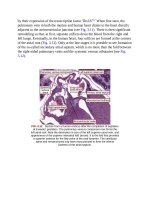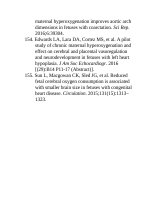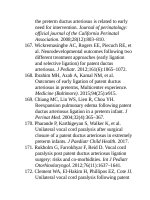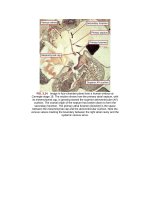Andersons pediatric cardiology 1180
Bạn đang xem bản rút gọn của tài liệu. Xem và tải ngay bản đầy đủ của tài liệu tại đây (96.49 KB, 3 trang )
FIG.44.19 Pressuretraceshowsthedifferencebetweenpeak-to-peak
andpeakinstantaneousmeasurementsofpressurebycatheterization.
Notethatthepeak-to-peakgradientislower.
NaturalHistory
Valvaraorticstenosishasawidespectrumofanatomicandclinicalvariations.
Criticalaorticstenosisinnewbornsandinfantsrepresentsadistinctand
challenginggroupwithsevereobstructionatthevalvarlevelandductusdependentsystemiccirculation.Theymaybecomeseverelyillwhentheductus
closes,manifestingwithlowcardiacoutput,inadequatesystemicperfusion,and
severemetabolicacidosis.
Mostpatients,especiallythosewithbicuspidaorticvalves,willremain
asymptomaticduringchildhood.Overtime,theleafletsbecomethickenedand
fibrotic,resultinginprogressiveaorticstenosis.Ifuntreated,chronicsevere
aorticvalvestenosiswillresultinsymptomsofexerciseintoleranceandriskfor
complicationssuchascongestiveheartfailureandsuddendeath.
Therateofprogressionofaorticstenosiscanbehighlyvariable.Patientswho
werediagnosedatayoungerageand/orhadahigherdegreeofstenosisatthe
timeofpresentationtypicallyhavemorerapidprogression.59,60However,the
majorityofchildrenwithbicuspidaorticvalvewillremainasymptomatic,with
only1in50havingclinicallysignificantvalvediseasebyadolescence.61Dueto
progressivecalcificationand/orthickeningofbicuspidaorticvalvesovertime,
themajorityofpatientsdevelopsignificantvalvestenosisand/orregurgitationby
thefourthandfifthdecadeoflife.62
Youngerageandhigherdegreeofaorticstenosisatthetimeofdiagnosisare
riskfactorsformorerapidprogressionandneedforintervention.IntheJoint
StudyoftheNaturalHistoryofCongenitalHeartDefects,patientspresenting
withaorticstenosisatyoungerthan2yearsweremorelikelytohaveprogression
and68%ultimatelyrequiredsurgicalinterventionduringthe4-to8-yearfollowupperiod.63Inthelong-termfollow-upstudyofthissamecohort,thosepatients
whooriginallyhadamilddegreeofstenosis,withcatheter-derivedaorticvalve
gradientslessthan25mmHg,hada20-yearfreedomfromaorticvalvesurgery
of87%,whichwassignificantlyhigherthan38%freedomfromsurgeryinthose
patientswithoriginalgradientsgreaterthan50mmHg.64
Chronicsevereaorticvalvestenosismaybetoleratedwithoutovert
symptoms,buteventuallyastheleftventricledecompensates,symptomsof
angina,syncope,orheartfailurecandevelop.Aftertheonsetofsymptoms,the
averagesurvivalis2to3years,withahigherriskofsuddendeathrelativeto
asymptomaticpatients.65Suddendeathoccurredin5%oftheNaturalHistory
Studycohortandwasrelatedtoseverityofvalvestenosisandprevioushistoryof
valveintervention.64However,inamorerecentstudyofmorethan500patients
withcongenitalaorticstenosis,suddendeathwasanuncommoneventwithan
estimatedincidenceof0.18per1000patientyears.66Inalongitudinalstudyof
622adultswithasymptomaticbuthemodynamicallysevereaorticstenosis
followedforupto5years,suddendeathoccurredatarateof1%peryear.67
Endocarditisisalsoawell-knowncomplicationinpatientswithbicuspid
aorticvalve.TheSecondJointStudyoftheNaturalHistoryofCongenitalHeart
Defectsestimatedtheriskforendocarditisof0.27%peryearforpatientswith
congenitalaorticvalvestenosis,whichwas70-foldhigherthanthegeneral
population.68Amorerecentpopulation-basedstudyofOlmsteadCounty,
Minnesotaestimatedtheincidenceofendocarditisofpatientswithnative
bicuspidaorticvalvesof9.9per10,000patientsyears,whichwas16.9times
highercomparedwiththegeneralpopulation.69
ManagementofCriticalAorticStenosis
MedicalManagement
Criticallyillneonatesarestabilizedbyaggressiveresuscitation(ventilatoryand
inotropicsupport,correctionofacidosis,andprotectionofmultiorganfunction),
whilepatencyofthearterialductismaintainedbyprostaglandinE1infusion.A
trialdiscontinuationofprostaglandinsshouldbeundertaken.Intervention
(balloonvalvuloplastyoropenvalvotomy)isindicatedonasemielectivebasisif
ductalclosureistolerated.However,dependencyontheductalcirculationisa
clearindicationforneonatalintervention.Younginfantswithsevere
symptomaticaorticstenosisresultinginheartfailure,respiratoryinsufficiency,
orpoorgrowthmayalsorequireinotropicmedicationsanddiureticspriorto
aorticvalveintervention.
TimingofIntervention
Intheneonatewithcriticalaorticstenosisandductal-dependentsystemic
circulation,theremaybevaryingdegreesofhypoplasiaoftheleftventricleand
otherleftheartstructures.Thekeyissueinthispopulationistodecidewhether
left-sidedstructuresareadequatetosustainthesystemiccirculationand,ifso,
whatkindoftreatmentisthemostbeneficial.70–73Studieshaveproposed
formulasincorporatingpreoperativeclinicalandechocardiographicfeaturesthat
couldpredictwhichsubjectswithmultiplesmallleftheartstructuresmayhave
improvedsurvivalwithaNorwoodstage1singleventriclepalliationcompared
withabiventricularrepairthatwouldincludeaorticvalvotomy.72,74–77Neonates
withcriticalleftventricularoutflowtractobstructionwhounderwent
biventricularrepairbutwerepredictedtohaveasurvivaladvantagewithsingle
ventriclepalliationhadworseoutcomes,includingearlyneedforreintervention
andhighermortality.78
Factorsthatwouldsuggestimprovedoutcomeswithsingleventriclepalliation
includesignificantmitraland/oraorticannulushypoplasia,ratioofleftandright
ventricularlengthslessthan0.8,acardiacapexnotformedbytheleftventricle,
andpresenceofendocardialfibroelastosis.72,75,76Predominantlyretrogradeflow
intheascendingaortaissuggestiveofseverelyhypoplasticleftheartstructures
andmostoftenasingleventriclepalliationwillbenecessary;however,the
presenceoftotalorpredominantantegradebloodflowintheascendingaortaand
transverseaorticarchcorrelateswithsurvivalafterabiventriculartypeof
repair.79









